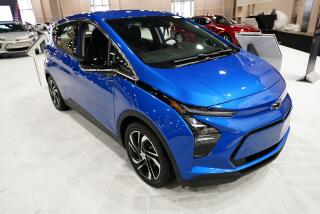Car Satisfaction Ratings--How Do They Rate?
Sometimes it’s announced in a news story, sometimes in an auto advertisement. But wherever one reads of a car rated No. 1 “according to a survey by J. D. Power & Associates,” it has the ring of authority and prestige.
There are plenty of other car ratings, from car magazine car-of-the-year awards to insurance company rankings of cars for collision repair costs. Best-known and most comprehensive are the regular auto reviews in Consumer Reports, particularly its annual auto issue, which is designed to help the average consumer figure out his own best buy. But J. D. Power surveys are much-cited, often headlined and heavily promoted by manufacturers and have become, in their way, equally influential.
However they benefit consumers, they certainly benefit manufacturers. In a survey released last June of new car owners three months after purchase, the Buick LeSabre came in second to the Nissan Maxima for “fewest problems per 100 cars.” The LeSabre was then advertised as “the most trouble-free car built in America,” according to J. D. Power. Sales took off: May sales were only 5.1% higher than the previous year, but sales in July and August were, respectively, 91% and 124% more than in 1988.
Up to 25,000 per Survey
The surveys also advertise J .D. Power & Associates, an Agoura Hills market research firm serving the auto industry. Founded in 1968 and still headed by J. David Power III, it produces regular reports and “forecasting publications” for manufacturers, suppliers and dealers, consults with them and helps train their salespeople. The “syndicated” surveys offered to subscribers, and briefly excerpted for public consumption, are only the tip of the iceberg.
Absolutely “unbiased and balanced,” these surveys only tally consumer opinions--up to 25,000 per survey, says Power spokeswoman Patty Patano. “Our ultimate goal,” she says, “is to help the consumer clearly draw a distinction.”
But Power surveys aren’t really addressed to the consumer and the selected information that gets to him can be downright confusing. For starters, there are several Power surveys, bunched together at midyear and not always distinct. There’s the customer satisfaction index, polling car owners on product quality and dealer service after 12 months of ownership. There’s the initial quality survey, polling new owners about their first three months’ experience, particularly with any problems that surfaced. And there’s a sales satisfaction index, polling them on the purchase and delivery of their new car.
Each survey is divided further, with much overlapping, rating vehicles among brands, among models, among cars of like size or type or country of origin. Nissan can therefore advertise in one place that in Power’s initial quality survey it was No. 1 (among Asian imports) and boast elsewhere that it was “trailing only” Mercedes and Porsche among manufacturers, or that its Nissan Maxima ranked highest among models.
Small Sub-Categories
The rankings also permit some skew. Cadillac was indeed the highest-ranked domestic brand in the customer satisfaction index--in its position as fifth after Acura, Mercedes, Honda and Toyota. Buick was the most trouble-free domestic brand on the initial quality survey but only behind six foreign brands.
Car makers could even make something of less, and have, boasting of their ranking in a survey’s small sub-category. They could have high marks for the customer’s waiting time at a dealership (part of the customer service survey), or a high ranking on “problem repairability” (part of the initial quality survey).
Aside from the difficulty in keeping track of who’s really No. 1 and why, what of it all? Who among laymen even knows what “problem repairability” is? Doesn’t anyone want to know what exact problems surfaced in a car averaging only 133 problems per 100 cars--transmission leaks or loose ashtrays?
The public gets just an impression and only of goodness: J. D. Power doesn’t publicly release what it calls “the lower half of the study,” the below-average rankings in surveyed categories. Indeed, the company’s policy, declares David Whiteside, director of publications, is to “accentuate the positive and allow credit to be taken where credit is due.”
Most helpful to car companies, it’s only half helpful to consumers, who might find it equally helpful to know what cars came in at the bottom of the rankings--information leaked this year by Automotive News, which got the full initial quality survey from a J. D. Power client. The next issue carried a letter from Power himself, criticizing the publication of a “partial story” which, given the “sophisticated data interpretation issues involved,” was “incomplete and in some cases misleading.”
‘Stimulating the Industry’
Finally recognizing perhaps that a client’s exploitation of the rankings can also be misleading, J. D. Power & Associates--whose copyrighted material can’t be quoted without permission--is working on some clearer guidelines and better control over what can and can’t be said. But that doesn’t solve the other problem, which is that the survey information released to the public is just not very informative, a summary of consumer opinion without data, detail or explanation.
Actually, informing the public is not J. D. Power’s goal. Power wants to help consumers only indirectly by, as Whiteside writes, “stimulating the industry to do a better job.”
For information, there’s always Consumer Reports, published by Consumers Union, which permits no advertisement of its judgments. The CR survey gives consumers actual data on 150 cars--their size, comfort, ride, fuel use and price. In each class, CR recommends (but doesn’t rank) some cars as better than average in performance and reliability. It also provides a repair history for up to six years on each model, with specific details provided by consumer responses covering 562,000 cars.
“Most surveys are very short term,” says Robert Knoll, head of Consumers Union’s auto test division, although new car buyers are increasingly interested in repair information, and used car buyers even more so. Consumer Reports, he says, “is the only place you can get it.”






